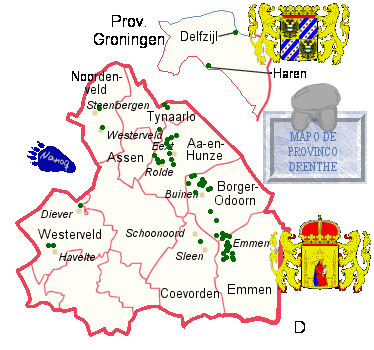
 |
Nederlando
|

|
|
|
En la Reĝlando Nederlando ni trovas 54 megalitaj tomboj, sed neniuj aliaj meglitoj kiel ŝtoncirkloj ktp. Du ŝtontomboj troviĝas en la provinco Groningeno (Groningen) [ĥroningen] (unu de ili en la AquariOm-muzeo de Delfzijl [delfzajl] unu en la komunumo Haren). La ceteraj tomboj distribuiĝas en ok komunumoj de la provinco Drento (Drenthe) [drente], sude de Groningeno. La plej granda parto de ili estas portaleca tomboj aŭ koridortomboj. 14 de ili havas pli-malpli bone konservitan ŝtonringon. Ĉiuj tomboj estas numeritaj laŭ ilia posicio de norde suden. Antaŭiras la numeron litero laŭ la provinco en kiu ili troviĝas. G signifas Groningeno, D Drento. Tiel D1 estas la plej norda, D54 la plej suda tombo en la provinco Drento, tamen tiu sistemo ne estas sekvita plej konskvence. La plej granda megalita tombo de Nederlando estas la tombo D27 en Borger [borĥer]. Tre vidinde estas ankaŭ Tombo D54 en la arbaro de Emmen (Emmerdennen), kie 1809 staris Napoleono. Unika siaspece estas D13 en Eext (komunumo Aa-en-Hunze); ĝi estas tiel nomata ŝtupareca tombo. Same belvida estas tombo D49 en Schoonoord en la komunumo Coevorden [kuvorden]. Tiu bela koridora tombo estas parte rekovrita sub sia termantelo, tiel ke oni ricevas bonan impreson kiel aspektis tiuj tomboj oriĝine. Ĉiuj megalitaj tomboj en la Reĝlando devenas de la funelpokala kulturo, de kiu on povas admiri multajn elmetaĵojn en la Drenta Muzeo en Assen. La tomboj ĝenerale estas tre bone konservitaj kaj restaŭritaj, kvankam ofte okazas ke mankas ŝtonoj. Ne ĉiam ekzistas gvidiloj, sed ofte troviĝas signo se la tombo kuŝas kaŝe.
|
In den Niederlanden sind 54 Megalithgräber zu finden, jedoch keine anderen Megalithen. Zwei davon befinden sich in der Provinz Groningen (eines im AquariOm-Museum von Delfzijl, eins in der Gemeinde Haren), die restlichen 52 in acht Gemeinden der Provinz Drenthe. Die Gräber sind entsprechend ihrer Lage von Norden nach Süden durchnummeriert. Je nach der Provinz in der sie sich befinden ist der Nummer ein Kennbuchstabe vorangestellt: G für Groningen und D für Drenthe. D1 ist also das nördlichste, D54 das südlichste Großsteingrab der Provinz Drenthe, wobei allerdings dieses System nicht konsequent eingehalten wurde. Die meisten niederländischen Großsteingräber sind Portal- oder Ganggräber. 14 davon haben einen Kranzstein oder mehr. Das größte Megalithgrab der Niederlande ist das Grab D27 ("De onbesuidste steenhoop") in Borger / Drenthe. Sehr sehenswert ist auch das Grab D54 im Wald von Emmen (Emmerdennen), wo auch Napoleon 1809 stand. Einmalig in seiner Art ist D13 ("Eexter gravkelder") in Eext (Gemeinde Aa-en-hunze), ein sogenanntes Treppengrab. Ebenfalls sehr schön anzuschauen ist das Grab D49 "De papeloze Kerk" ei Schoonoord in der Gemeinde Coevorden. Dieses schöne Ganggrab ist teilweise wieder unter seinem Erdmantel gebettet, so daß man einen Eindruck gewinnen kann, wie die Gräber ursprünglich ausgesehen haben. Sämtliche Megalithgräber im Königreich stammen von der Trichterbecherkultur, von der zahlreiche Fundstücke im Drents Museum in Assen zu besichtigen sind. Die Megalithgräber sind in der Regel gut erhalten und restauriert, wenngleich es oft vorkommt, daß einzelne Steine fehlen. Die Wege manchmal nicht ausgeschildert, doch meist findet sich ein Hinweisschild, wenn es etwas versteckt liegt. |
In the Kingdom of the Netherlands you can find 54 megalithic tombs, but no further megaliths. Two of them are in the province of Groningen (one of them in the AquariOm Museum of Delfzijl, the other one in the municipality of Haren). The other 52 tombs can be seen in eight different municipalities of Drenthe. Most of them are portal- or passage-graves. 14 of them have a ring of kerbstones. The biggest megalthic tomb in the Netherlands is D27 in Borger. Also worth a visit is D54 in the forest of Emmen (Emmerdennen), where also Napoleon had a rest. Really unique is D13 in Eext (Municipality Aa-en-Hunze), a so-called stair-grave. All of the megalithic tombs in the Kingdom come from the funnelbeaker-culture of which many artifacts can be seen in the Museum of Drenthe in Assen. Most of the graves are well preserved although sometimes the one and other stone may miss. Sometimes the ways are not shown well, but mostly there is a sign when the grave lies somehow hidden. |